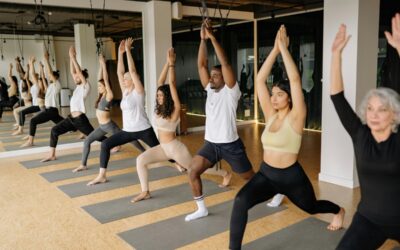Discipline isn’t always about restriction; it’s often about discovering practices and routines that lead to growth. In the realm of wellness, two disciplines stand out: yoga and Pilates. Although both practices aim to support physical and mental well-being, their approach and focus differ. Let’s look at yoga vs. Pilates to explore the differences between these two disciplines and help you determine which one is best suited for you.
Understanding the Essence:
Yoga is an ancient practice that has been around for thousands of years. It emphasizes the union of mind, body, and spirit. Yoga cultivates physical strength, flexibility, and inner peace through a combination of asanas (poses), pranayama (breath control), and meditation. Yoga can be practiced in many different styles, from the slow and meditative to the fast-paced and challenging. Warrior 2 (Virabhadrasana II), a classic yoga pose, strengthens the legs and arms, opens the hips and chest, and fosters a sense of focus and determination.
Yoga cultivates physical strength, flexibility, and inner peace through a combination of poses, breath control, and meditation.
On the other hand, Pilates was developed by Joseph Pilates in the early 20th century. It focuses on core strength, alignment, and body awareness. Pilates exercises often involve precise movements performed with control and concentration. The Pilates Hundred, a classic exercise, engages the core muscles while promoting circulation and breath awareness. Pilates can be practiced on a mat or using specialized equipment such as a Reformer or Cadillac.
Pilates focuses on core strength, alignment, and body awareness.
Yoga’s Role in Nurturing Well-Being:
Yoga is a holistic practice that addresses not only physical health but also mental and emotional well-being. Regular yoga practice enhances flexibility, balance, and strength, but its focus continues beyond these traits. Yoga also cultivates mindfulness, stress reduction, and spiritual growth. For example, Sun Salutations (Surya Namaskar) offers a dynamic flow that energizes the body and calms the mind, making it a cornerstone of many yoga practices. Additionally, yoga is known to help alleviate a wide range of health conditions, including anxiety, depression, and chronic pain.
Pilates Focus on Wellness:
Pilates, with its focus on core stability and alignment, offers a different approach to physical conditioning. These exercises target deep muscles, promoting spinal alignment, postural awareness, and overall body strength. Pilates particularly benefits individuals with back issues or those seeking overall toning and sculpting. The Pilates Roll-Up, which involves sequential spinal articulation, strengthens the core and improves spinal flexibility. Pilates can also help prevent injuries and improve athletic performance by enhancing overall body awareness.
The Harmony of Practice:
While yoga and Pilates have distinct methodologies, they share common principles such as breath awareness, concentration, and mind-body connection. Both practices encourage individuals to listen to their bodies, honor their limitations, and explore areas for growth. Whether you’re flowing through a yoga sequence or engaging in Pilates mat work, the emphasis on mindful movement fosters a sense of presence.
Choosing Your Path, Yoga vs. Pilates:
Yoga may resonate deeply with you if you seek a practice that integrates physical, mental, and spiritual aspects. Conversely, Pilates might be the ideal fit if you prioritize core strength, alignment, and precise movement. It’s essential to choose a practice that feels authentic and nourishing. Explore different classes and styles to find what works best for you.
Both yoga and Pilates offer unique benefits that can enhance your overall well-being.
Ultimately, the choice between yoga and Pilates depends on your preferences, goals, and needs. Both practices offer unique benefits that can enhance your overall well-being. Whichever practice you choose, it’s essential to listen to your body, be patient with yourself, and approach your practice with a sense of curiosity, playfulness, and openness.
With dedication and consistency, you can cultivate a stronger, more flexible, and resilient mind, body, and spirit. Remember, the essence of discipline and wellness practices lies not in rigidity, but in their role in supporting your life and goals.
Join the conversation on Facebook or Instagram!





0 Comments